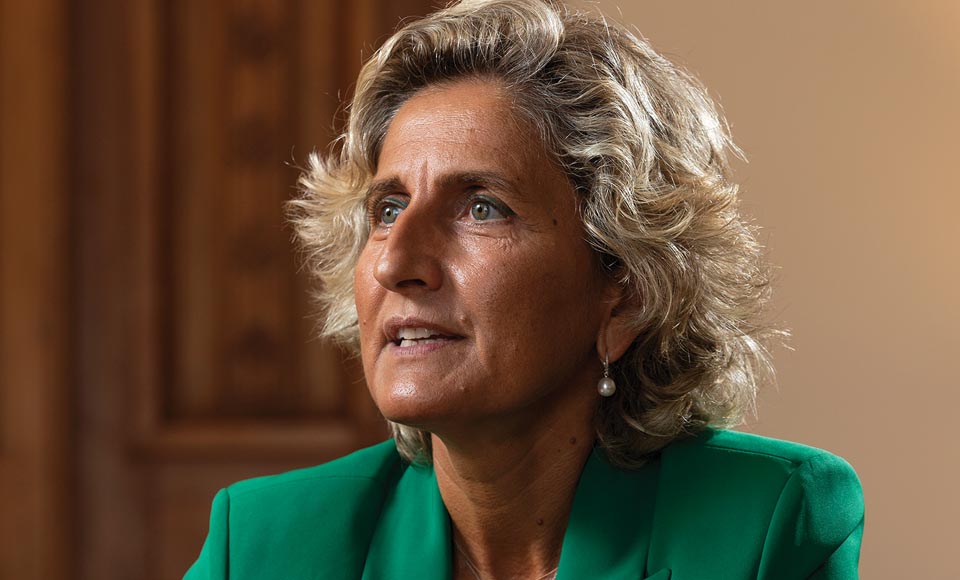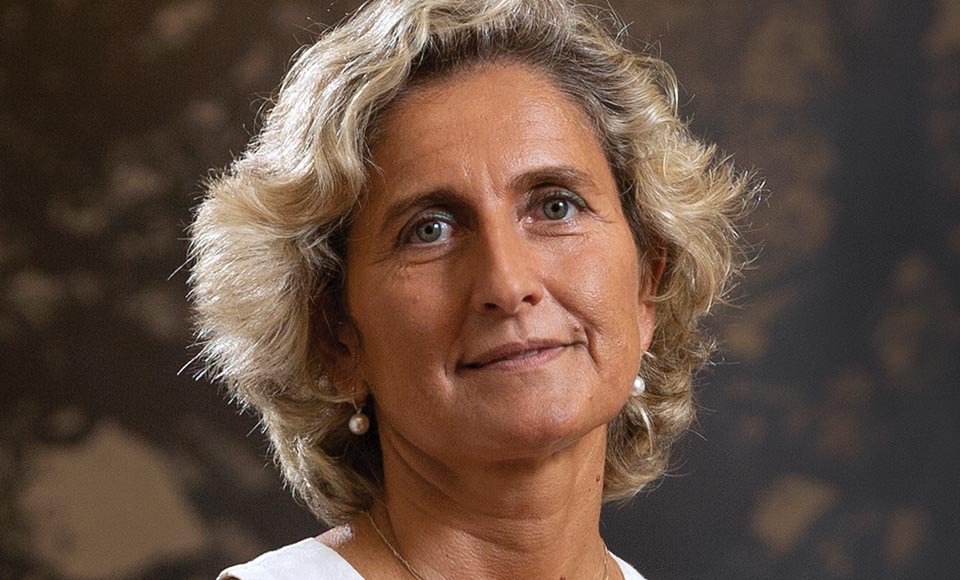Interview with Ana Abrunhosa, minister of Territorial Cohesion
Ricardo David Lopes
In 2019, she promised to be the “ambassador” to the government for the cause of reducing the road tolls in inland regions. And she was successful. “That was my mission impossible”, Ana Abrunhosa declared, highlighting the importance of reducing the costs within those regions. The Minister of Territorial Cohesion took those regions into the interior of the Council of Ministers, establishing synergies among government sectors that would not otherwise have existed for the populations who, through option or need, live outside the major urban centres.
This is a new Ministry. Has it been difficult to launch a new area of governance?
It’s challenging to set up a Ministry that never before existed but that serves to meet a need.
What was the rationale behind setting up the Ministry of Territorial Cohesion?
In governments, each sectorial Ministry perceives the territory from its own point of view but there is a need to do this in an integrated approach. Our objective is to provide an integrational dimension to interventions in the territory and ensure that the various different levels of administration are mutually integrated. We have councils, inter-municipal communities and ourselves [the Ministry of Territorial Cohesion] who oversee the CCDR – the Regional Coordination and Development Commissions.
Indeed, the minister was formerly in charge of one commission, for the Centro region…
Yes, the CCDRs hold competences for the environment, regional development, planning. In themselves, they already have the mission to coordinate activities ongoing in healthcare and education in their region and all the various actors. Setting up this ministry ended up bringing the territory into the Council of Ministers where I, as a minister, do not represent a sector but rather the territory. And we have the community funds to apply in service of the ministry. Let me give you an example: imagine that we want to resolve a problem involving poor school results in a given place…
That is a problem for the Ministry of Education…
Not exclusively. This is a community problem. When we want to act against education failures, we have to intervene in schools and the school communities and involving not only the Ministry of Education but also the municipalities, the inter-municipal communities and we, through the CCDRs, have the community funds as a “carrot” and incentive so that everybody works together. We are able to bring together the various sectors of government for the resolution of problems alongside the various actors in the region.
Does this organic structure enable the maximisation of community funds?
Yes and that is the objective: that this Ministry, not sectorial in approach, supports education, higher education, companies and business associations, etc. If, when we are applying funds to a region, we don’t have an integrated vision of problems and the path that we want to take, how are we going to make this region more competitive?
Also supporting companies…
That’s not enough. We have to have qualified workers, higher education institutions have to work with companies, we have to involve the municipalities. When we talk about stimulating the competitiveness of a territory, we are referring to universities, polytechnics, business associations, micro, small, medium and large companies, and municipalities in a strategy of collective efficiency. If the financing is managed by the ministries, each will apply its own vision of the problems and not a systemic vision as the CCDR deploys.

“IN GOVERNMENTS, EACH
SECTORIAL MINISTRY PERCEIVES
THE TERRITORY FROM ITS OWN
POINT OF VIEW BUT THERE IS A
NEED TO DO THIS IN AN
INTEGRATED APPROACH.”
Are there gains in efficiency?
Yes, this model means objectives can be achieved with far greater efficiency, congregating the efforts of government nationally and locally. We may then deal differently with situations that are different. We may have a national policy but when we apply this territorially, we have to take into account the characteristics and actors in the respective region. We work in close proximity with the territory – I like to consider myself the ambassador for the territory to the Council of Ministers.
So, the role of the CCDRs is central…
Yes, the presidents and vice-presidents have already been elected, now it is about integrating into the CCDRs the representatives that each ministry has in the regions so that they may look towards that territory as a whole and therefore be more successful through to arriving at regionalisation even if not in this parliamentary session.
Are there EU experiences with similar ministries?
In Spain, for example, there is a Ministry of Ecological Transition and Demographic Challenge, with which we have met and set out the first common strategy for cross-border development. There is now already an action program, with concrete projects as in the case of the IC-31, in Beira Baixa, the Nisa Bridge, the Alcoutim Bridge, which are instrumental to any joint development strategy. There is another example, the cross-border worker…
How do you define territorial cohesion?
We have to guarantee that when the country grows, all the Portuguese benefit from this progress irrespective of whatever location they are in. The dimensions of territorial cohesion are those that affect that quality of life of people – housing, for example, is extremely important both in inland regions and the metropolitan areas. Issues around access are also fundamental also perceived in different ways in different regions. The problems of inland regions are not the same as those on the coast so the solutions need to be different. Another important dimension is ensuring people have decent jobs and quality public services.
And how to get those jobs?
Decent work implies inland territories not getting left behind in economic activities.
Do you have any statistics confirming any trend towards openness or the actual transfer of companies to inland regions?
Yes. One of the first things that we did was to, with community funding, set up a support measure for investment in the interior both for companies that were already there to enable them to expand their activities as well as to attract new companies. As a rule, for each 100 euros, 30 are a non-repayable grant to support investment whenever this is innovative and we are simultaneously providing support for companies recruiting qualified staff.

“WE ARE ABLE TO BRING
TOGETHER THE VARIOUS
SECTORS OF GOVERNMENT
FOR THE RESOLUTION OF
PROBLEMS ALONGSIDE THE
VARIOUS ACTORS IN THE REGION.”
Has there been much take-up?
Yes, and there has also been support for people setting up their own businesses. For those living on the coast and relocating to the inland regions, we attributed a family subsidy that may rise to 4,800 euros for mobility related costs.
Are there now more higher education institutions in these regions?
In two to three years, we have doubled these numbers, primarily through polytechnics that open poles and set up programs in partnership with companies. The role of higher education institutions is crucial as they attract young people and foster innovation activities in their surroundings. In this case, we work with the Ministry of Science, Technology and Higher Education. In launching the investment support measures, with the Economy Ministry and for supporting recruitment with Social Security.
How do you measure cohesion?
Unfortunately, we do not have a consensual indicator that does this at the European level. We are trying, working with some universities, to draft a proposal for a territorial cohesion index. We have to be proactive and make this proposal to Brussels. I would very like to, by the end of this parliamentary session, to already have this composite indicator implemented.
Did the pandemic reveal problems with cohesion in our territory?
The pandemic served to show to the Portuguese the value of the interior, the security, the quality of life. For many, these regions were a refuge, others discovered them due to the pandemic and the demand for housing has boomed. We hope that this will help contain the loss of population from the interior. The pandemic also served to reveal terrible problems in the housing in urban centres and the lack of public spaces. We have to take advantage of this window when people are willing to change their lives and continue to create incentives. For certain economic activities, being in a city is highly advantageous, but for others, not so much and where not completely on the contrary.
Will the PRR – the Recovery and Resilience Plan accelerate the cohesion process?
That’s the correct expression; accelerate transformation.
How?
The priority areas are defined – health, education, social. Over half of the projects have already been contracted and we have until 2023 to procure the remainder. Implementation is going to be extremely decentralised at the level of the CCDRs, municipalities and entities in the terrain. We have to have everything implemented by 2026 but the PRR does not replace the community support framework.
Are there areas or measures that this framework cannot support?
For example, we have had great difficulties in supporting cross-border connections, highways, and these are projects that, from the outset, are not eligible for financing. In housing, we are going to apply one part of the PRR and what we ae not able to get from this source may find a solution via the “Portugal 2030” program.
What does PRR bring to housing?
It works like this: a municipality sets out a local housing strategy and identifies those residences that do not have dignified living conditions. This also identifies lands where housing might be built for young workers who do not earn enough money to pay for housing at the market rate but who are able to pay an accessible level of rent. Subsequently, the municipality contracts the IHRU – the Institute of Housing and Urban Rehabilitation and benefits from financing for the rehabilitation, for the construction of new housing. There is also support for social equipment and infrastructures or to purchase new vehicles, electric for example.

“WE MAY HAVE A NATIONAL
POLICY BUT WHEN WE APPLY
THIS TERRITORIALLY, WE HAVE
TO TAKE INTO ACCOUNT THE
CHARACTERISTICS AND ACTORS
IN THE RESPECTIVE REGION.”
Does the PRR have different funding for interior and coastal region?
No, this always depends on the projects but in “Portugal 2030”, a very significant proportion of funding will be for the interior.
“Portugal 2030” has yet to be signed off…
We are working on a partnership agreement, with a set of principles and rules, between the Portuguese state and the European Commission for the application of funds and the logic will be to continue with the best examples from “Portugal 2020” but with a greater focus on companies that shall receive around 40% of the funding in “Portugal 2030”.
And in the PRR, are there opportunities for companies?
The PRR supports totally different projects to those of “Portugal 2030”. There is a mobilising agenda that, in sum, sets up poles, consortia among academia, business and municipalities. Under “Portugal 2030”, we support companies individually.

“THE PROBLEMS OF INLAND
REGIONS ARE NOT THE SAME
AS THOSE ON THE COAST SO
THE SOLUTIONS NEED TO BE
DIFFERENT. ANOTHER IMPORTANT
DIMENSION IS ENSURING
PEOPLE HAVE DECENT JOBS.”
Did the previous framework, “Portugal 2020”, also dedicate 40% to companies?
It did not differ greatly. Under the auspices of “Portugal 2020”, we have supported over 20,000 company investment projects that account for the investment of 13 billion euros, with one-quarter going to inland regions. Around 80% of the funds went to SMEs and 70% of these projects are industrially based. We also opened a new line that provides support for the recruitment of Phd and Master’s degree holders by companies located inland.
Are there any results yet?
We have already supported almost 900 doctoral, master’s and graduate degree holders to enter companies engaged in innovative activities in inland regions. There is also the Return Program, for qualified young people who left the country and want to return to inland areas. Just in direct support, they receive 7,600 euros, and throughout five years incur only half the rate of IRS on their earnings. Now, we are going to allocate health professionals to the IPSS. The idea is to finance the IPSS for contracting these people who are abroad and who, simultaneously, receive direct support. The pandemic did show us that many IPSS have workers who are not properly qualified.
What is the measure, or the measures that you are most proud of as a minister?
The reduction of tolls on inland roads. That was my mission impossible!
And that is a long lasting “battle”, the question of tolls…
Yes, but I managed but not on my own of course.
Even at the centre of government, that must have been a fairly heated debate…
That’s always the case but the interior has always to be there for the government and very much inside the Council of Ministers. Reducing the tolls was very important and helped in lowering relevant contextual costs.
In “Portugal 2030”, are there opportunities for companies in inland regions?
For all of them!
How much are we talking about?
I cannot advance figures yet but one of the “Portugal 2030” priorities is the competitiveness of interior territories. It is through this competitiveness that cohesion is generated – with measures dedicated to supporting investments in the interior, contracting qualified staff by the companies, making the surroundings attractive to companies, continuing with the campaign to lower contextual costs…
What others – apart from the road tolls?
For example, one terrible contextual cost is the lack of mobility in interior regions. The lack of accessibilities – a problems that many territories are now “attacking” in a joint approach – is a contextual cost. One of the fundamental areas for “Portugal 2030” is to, beyond competitiveness, the environment, including also digitalisation, inequalities and demography – all of this relates to territorial cohesion.
In addition to the tolls mentioned, what other measures do you have up your sleeve that might bring you equal pride?
I would like to be remembered as a minister able to establish the conditions to attract more companies and qualified persons to the interior. However, above all, I want to be remembered as somebody with their feet in the terrain: we are not going to repopulate our inland regions, what we want is that they are not abandoned and that, even with fewer people, there are economic activities, life, and that people who choose to work there gain quality of life and do not feel that they have fewer opportunities in terms of culture, leisure, education or health due to living there. We can build the country in this fashion. I believe that if we do so, we will also be resolving problems on the coast.

“IN TWO TO THREE YEARS,
WE HAVE DOUBLED THESE
NUMBERS, PRIMARILY
THROUGH POLYTECHNICS.”




 THE BEST OF THE COUNTRYSIDE
THE BEST OF THE COUNTRYSIDE

